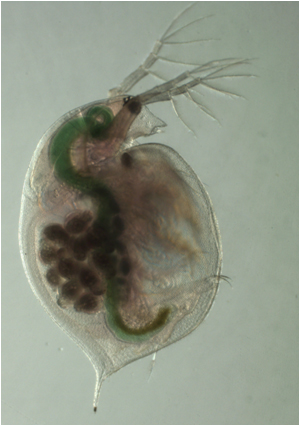Water Flea Circus: Five Questions With Dr. Jerry LeBlanc
This week’s edition of the journal Science contains a paper describing the genome of the water flea (Daphnia pulex). BioMed Central has also released a number of companion papers related to the genomics of the water flea, including one by Dr. Jerry LeBlanc, professor and head of NC State’s environmental and molecular toxicology department. LeBlanc uses the water flea as a model animal to investigate how environmental signals can influence sex determination and how environmental pollutants can interfere with this process.
We asked LeBlanc about his collaboration with the network of researchers investigating the water flea and the major implications of the work. Responses were lightly edited for style.
The Abstract: You are part of the Daphnia Genomics Consortium. What is it and what are its goals?
Jerry LeBlanc: The consortium consists of a network of 300-plus investigators who share the same vision of establishing the water flea (Daphnia) as a model organism in environmental and biomedical research. Daphnids are small freshwater crustaceans that have long been used in limnological, ecological and toxicological studies. The primary goal of the consortium is to expand the repertoire of the daphnid to include its use in biomedical research. To this end, the first major endeavor of the consortium was to sequence and characterize the entire genome of the organism. The genome of Daphnia pulex will be published this week in Science magazine. Companion papers, that describe various structural and functional aspects of the genome, are routinely being published in the journal BMC Genomics.

The Abstract: What are the findings and major implications of the Science paper?
Jerry LeBlanc: I expect that, in addition to describing the “mechanics” of the genome (gene sequence information, number of genes, chromosomal structure of the genome, etc.), the paper will describe how the daphnid genome has evolved to make this organism exquisitely in-tune with its environment. This will include the discussion of genes that allow for multiple reproductive strategies in response to different environmental conditions, genes that facilitate survival in diverse environments, and means by which the species can entirely avoid inhospitable environments by producing eggs that are in a state of suspended animation.
The Abstract: You recently published a companion paper, “Annotation, phylogenetics, and expression of the nuclear receptors in Daphnia pulex,” to this project. What were the major findings and implications of this paper and how did it fit into the puzzle?
Jerry LeBlanc: We used the sequenced genome to identify the full complement of nuclear receptors in this organism. Nuclear receptors are proteins that bind small molecules such as hormones, vitamins, lipids and environmental chemicals. These small molecules then instruct the receptor to regulate the activity of specific genes. For example, at puberty, testosterone can bind to its receptor and the receptor then regulates the activity of genes involved in male reproduction. We determined that daphnids express 25 of these nuclear receptors, 20 of which are common in animals from humans to flies. The remaining five nuclear receptors were unique to daphnids.
The Abstract: What can we learn from water fleas that we can’t learn from other commonly studied animal models?
Jerry LeBlanc: The information gained from our study has two fundamental implications. First, we identified several nuclear receptors in daphnids that are also found in humans. Accordingly, the study of these receptors in daphnids should provide insight into their function in humans. Daphnids have many unique qualities that favor its use as a model of human physiology. For example, the animals are extremely prolific, producing approximately 100 offspring over a two-week period. This affords a large number of offspring to evaluate aspects of oocyte maturation, embryo development and fetal well-being. Second, we identified nuclear receptors in daphnids that have never been identified in other species. These receptors likely regulate physiological processes that are unique to daphnids and will further advance our understanding of the ecologically important species.
The Abstract: Do you think that the biomedical research community will ever accept Daphnia as a model organism to study human physiology?
Jerry LeBlanc: Yes, I believe that daphnids will fill a niche among model species. In fact, the National Institutes of Health have recently recognized Daphnia as a model organism for biomedical research. This designation was largely due to the efforts of the Daphnia Genomics Consortium.
- Categories:


